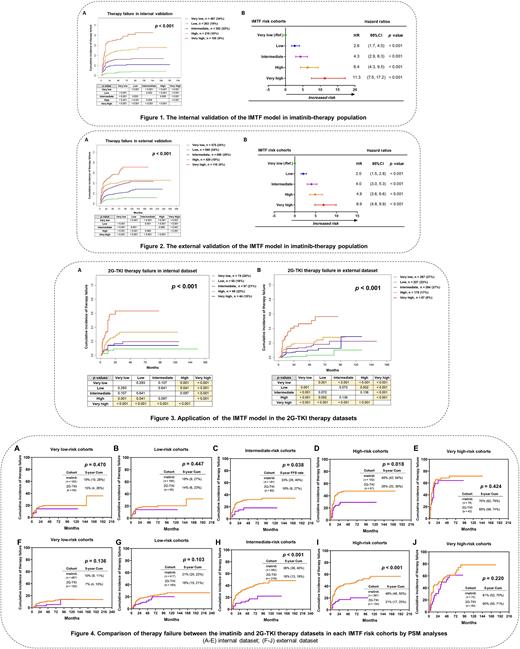Abstract
Objective Validate the imatinib therapy failure (IMTF) model in 3,752 subjects with chronic phase chronic myeloid leukemia (CML) receiving initial imatinib therapy, and further test prediction accuracy in 1,353 persons receiving initial a second-generation tyrosine kinase inhibitor (2G-TKI). Compare the cumulative incidences of therapy failure in each IMTF risk cohort between initial imatinib and a 2G-TKI therapy.
Methods Data from 1,356 consecutive subjects with chronic phase CML receiving initial imatinib therapy at one centre (Beijing, China) were interrogated as an internal dataset and compared with results in 2,396 similar subjects from 65 other centers in China, an external dataset to validate the IMTF model (https://www.nature.com/articles/s41375-022-01527-y.) The IMTF model divided subjects into the very low-, low-, intermediate-, high- and very high-risk cohorts. Data from 1,353 subjects receiving initial 2G-TKI therapy were also interrogated using the IMTF model to extensionally test predictive performance. Propensity score matching (PSM) was used to adjust the differences in baseline co-variates between subjects receiving initial imatinib or a 2G-TKI.
Results In the imatinib internal validation dataset, 467 (34%), 263 (19%), 302 (22%), 219 (16%) and 105 (9%) subjects were classified as the very low-, low-, intermediate-, high- and very high-risk cohorts. 5-year cumulative incidences of therapy-failure were 7% (95% Confidence Interval [CI] 4, 9%), 19% (15, 23%), 33% (29, 37%), 52% (46, 58%) and 78% (67, 89%; p < 0.001; Figure 1A). Hazard ratios (HRs) (very low-risk cohort as reference) were 2.6 (1.7, 4.0; p < 0.001), 4.3 (2.9, 6.3; p < 0.001), 6.4 (4.3, 9.5; p < 0.001) and 11.3 (7.5, 17.2; p < 0.001; p for trend < 0.001; Figure 1B). In the imatinib external validation dataset, 575 (24%), 589 (24%), 696 (29%), 420 (18%) and 116 (5%) were classified as the very low-, low-, intermediate-, high- and very high-risk cohorts. 5-year cumulative incidences of therapy-failure were 9% (7, 11%), 21% (16, 26%), 36% (25, 47%), 41% (33, 50%) and 58% (46, 70%; p < 0.001; Figure 2A). HRs (very low-risk cohort as reference) were 2.0 (1.5, 2.8; p < 0.001), 4.0 (3.0, 5.3; p < 0.001), 4.9 (3.6, 6.6; p < 0.001) and 6.9 (4.8, 9.9; p < 0.001; p for trend < 0.001; Figure 2B). In the internal 2G-TKI dataset, 74 (24%), 55 (18%), 67 (21%), 69 (22%) and 44 (15%) subjects were classified as the very low-, low-, intermediate-, high- and very high-risk cohorts. 5-year cumulative incidences of therapy-failure were 10% (4, 15%), 15% (3, 27%), 19% (5, 33%), 36% (13, 59%) and 63% (44, 82%) (p < 0.001; Figure 3A). There were no significant differences in therapy failure among the cohorts except those in the high- and very-high risk. In the external 2G-TKI dataset, 287 (27%), 227 (22%), 284 (27%), 179 (17%) and 67 (7%) subjects were classified very low-, low-, intermediate-, high- or very high-risk cohorts. 5-year cumulative incidences of therapy-failure were 3% (0, 6%), 10% (4, 16%), 18% (6, 31%), 24% (12, 36%) and 52% (25, 79%; < 0.001; Figure 3B). In PSM analyses, subjects in the intermediate- and high-risk cohorts in the 2G-TKI internal dataset receiving initial 2G-TKI therapy had significantly lower cumulative incidences of therapy-failure compared with those receiving initial imatinib therapy (p = 0.038 and 0.018) whereas therapy-failure was similar in the very low-, low- and the very high-risk cohorts (p = 0.42 - 0.47, Figure4A-4E). Similar results were obtained in the 2G-TKI external dataset (Figure4F-4J).
Conclusions The IMTF model accurately predicts therapy failure in persons receiving initial imatinib therapy and in those receiving initial 2G-TKI therapy. Subjects identified as intermediate- and high-risk using the using the IMTF model might benefit from initial 2G-TKI therapy whereas those in lower risk cohorts might not. If further validated by randomized controlled trial (in process), our data on preferred initial therapy should help physicians optimize TKI-therapy strategy in persons with chronic phase CML.
Disclosures
No relevant conflicts of interest to declare.
Author notes
Asterisk with author names denotes non-ASH members.


This feature is available to Subscribers Only
Sign In or Create an Account Close Modal